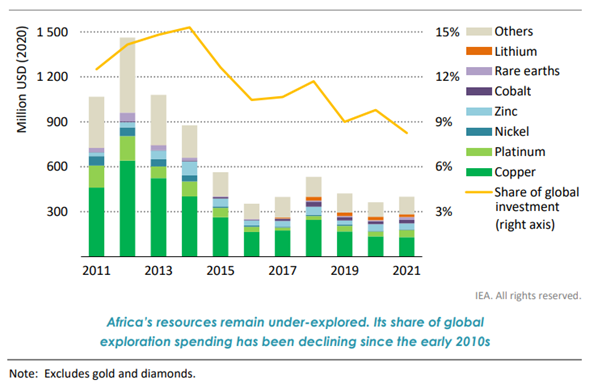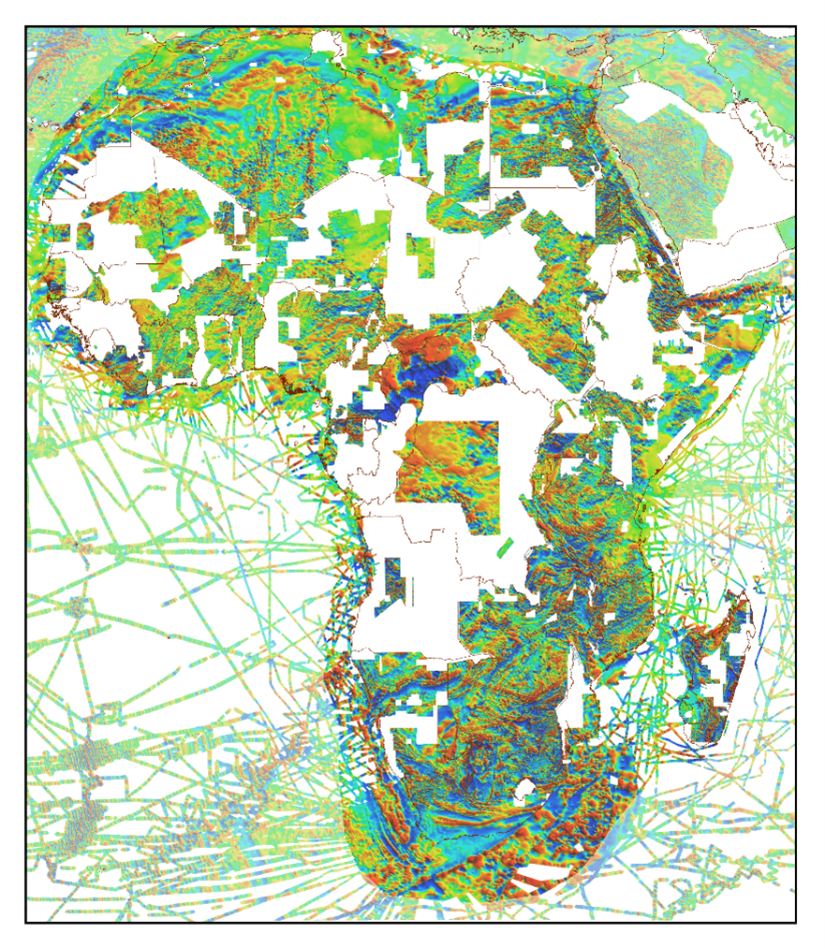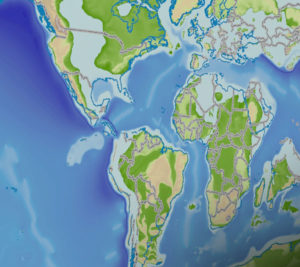Africa and Critical Minerals
With the ever-increasing demand for access to critical minerals vital to support the global energy transition, Africa’s vast natural resources present a significant opportunity. In 2022, the IEA reported that Africa has over 40% of the global reserves of cobalt, manganese and platinum – key minerals for batteries and green hydrogen technologies.
Whilst several African countries are leading producers of key minerals – such as cobalt in the DRC, platinum, chromium and manganese in South Africa and graphite in Mozambique, there remains significant unexplored potential.
As the IEA reported, exploration spending in Africa fell sharply between 2012 – 2016 and remains subdued (figure 1). Consequently, a large proportion of Africa’s mineral resources remain under-explored.
Getech’s unique compilation of African magnetic data can help reignite your African exploration programme and encourage inward investment, employment, and knowledge transfer opportunities for African state economies.

Figure 1: Investment in exploration for selected mineral resources in Africa, 2011-2021
Magnetic Data: A Key Exploration Tool
Magnetic data have long been recognised as a key tool in the exploration of mineral resources. They enable the cost-effective mapping and analysis of large areas to target exploration efforts thereby avoiding wasted effort, reducing risk and saving money.
Numerous successful use cases, which provide excellent analogues for exploring frontier areas, have been documented ranging from the mapping of regional structures to highlight potential mineralisation zones through to modelling the geometry of targeted ore bodies.
More specifically, magnetic data can particularly help in:
- The identification of mafic/ultramafics, which typically manifest as large magnetic anomalies due to the elevated Fe content (e.g Sudbury Complex, Ontario). Ultramafics are often associated with magmatic nickel deposits and have recently been identified as a key source for natural hydrogen.
- Identification and modelling of Iron Oxide Copper Gold (IOCG) deposits (in conjunction with gravity data). Our blog demonstrates how the interaction between haematite-rich and magnetite-rich parts of the ore bodies can be modelled in three dimensions where you have access to sufficient coverage of magnetic and gravity data (e.g. Olympic Dam, Australia; Carajás, Brazil).
- Mapping radiogenic granites, an essential starting point for hard rock lithium exploration (e.g. Greenbushes, Australia).
- Locating titanium sands, where monzanite minerals produce significant magnetic anomalies as well as detectable thorium radiation.
- Mapping the location and geometry of carbonatites which can contain economic concentrations of rare earth elements (e.g. Alno, Sweden; Phalaborwa, South Africa).
- Locating porphyry copper deposits where magnetite destructive alteration can often produce magnetic lows and where porphyry intrusives can be detected with the potassium channel of radiometric data.
- Identification of intra-crustal structures, often associated with major mineral deposits.

Figure 2. Example from the Bushfeld Complex in South Africa showing the prominent magnetic anomalies associated with mafic intrusions and the correlation to economic accumulations of various critical minerals.
Getech’s African Magnetic Data
Getech’s compilation of African magnetic data comprises a merge of approximately 400 legacy airborne surveys that have been recovered, edited, micro-levelled and reprocessed with consistent parameters (figure 3).
The result is an unparalleled, self-consistent dataset that enables cost-effective geological analysis of large regional areas to target your exploration efforts for a range of resources as described in the previous section.

Figure 3. Getech’s African magnetic data compilation.
Building on its initial inception as part of the African Magnetic Mapping Project (Fairhead and Green, 2015), this industry-leading dataset continues to expand and develop with 2023 updates including additional surveys in the Republic of Congo (figure 4), Mali and Somalia, and additional updates to coverage and processing in Libya, Kenya, Egypt, Uganda, Togo and Zambia.
The resolution of this dataset is an order of magnitude better than the public domain EMAG2 dataset over most parts of Africa (figure 5) enabling geological mapping and modelling in far greater detail.

Figure 4. Red flight lines show ~5,800 km of newly reprocessed data in Congo now added to our compilation.

Figure 5. Comparison of Getech data (left) vs public domain EMAG2 (vers. 3) in the vicinity of the Malawi/Mozambique border showing the higher resolution and additional detail and minimal interpolation over gaps away from primary data.
Exploration is Vital
Africa will undoubtedly play a key role in the production and supply of essential critical minerals as the energy transition accelerates. Key to this will be cost-effective exploration to encourage inward investment, unlock the potential of Africa’s vast natural resources and support Africa’s developing economies.
Getech’s magnetic dataset, together with its partner gravity compilation, provides an excellent tool to effectively map the extent and geometry of mineralisation zones to target exploration efforts.
For further information on Getech’s magnetic and gravity datasets, and minerals system analysis services, please contact the team at gravmag@getech.com
Written by Simon Campbell and Howard Golden
Related Getech content:
Finding the next IOCG monster | Getech | Unlocking the Earth’s Energy Potential
Exploration for Critical Minerals Must Increase | Getech | Unlocking the Earth’s Energy Potential
WEF Warns of the ‘Great Minerals Scramble’ | Getech | Unlocking the Earth’s Energy Potential
References:
Fairhead and Green (2015) Generating a high-resolution global magnetic model for oil and mineral exploration.The Leading Edge, v. 34, 9
IEA (2022), Africa Energy Outlook 2022, IEA, Paris https://www.iea.org/reports/africa-energy-outlook-2022, License: CC BY 4.0










